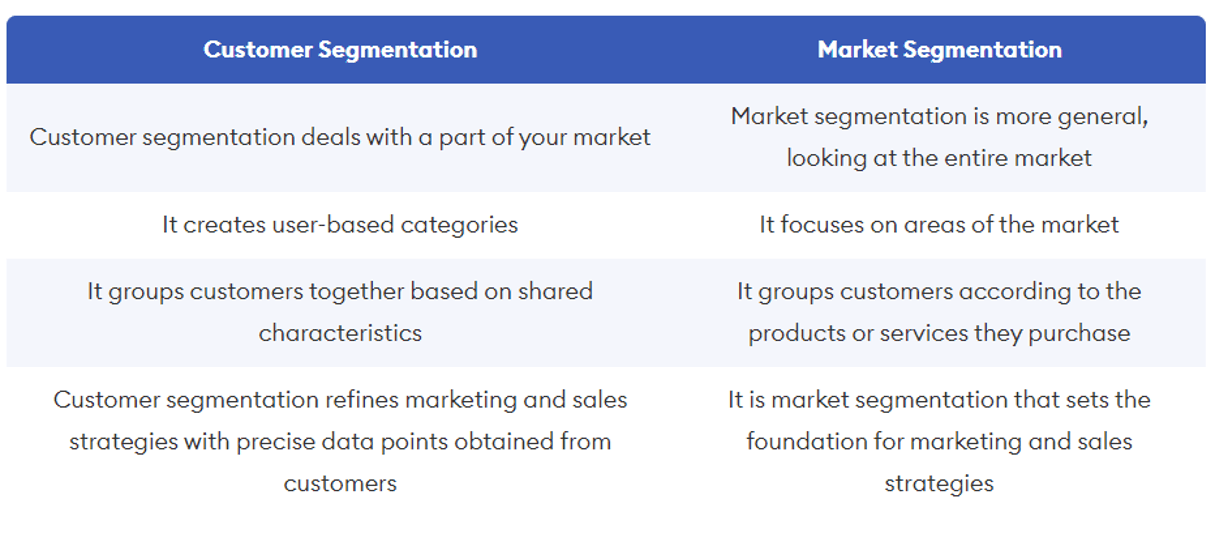Highlights
- Unveiling the significance of customer segmentation from childhood skills, the article stresses its pivotal role in understanding individual needs, preferences, and behaviors for effective marketing.
- Unraveling the nuances between customer and market segmentation, the piece underscores the importance of crafting a robust strategy for personalized connections and brand growth.
- From industry giants like Netflix and more, uncover the power of customer segmentation, predicting a future shaped by predictive analytics for sustained brand success.
In our formative years, we honed the skill of segmentation at its most basic level. From breaking down words to categorizing colors, food, clothes, and every facet of our surroundings, segmentation became second nature. As we navigated through each social stage of our lives, we compartmentalized things and aspects of our academic and professional journey too.
What is customer segmentation?
Customer segmentation is the practice of categorizing both current and prospective customers according to shared characteristics. By organizing customers into distinct classes, a business gains a deeper understanding of their needs, preferences, and purchasing behaviors. This insightful categorization enables the marketing and sales teams to customize their approaches, ensuring they connect with customers in the most resonant manner. The outcome of these targeted campaigns and strategies is strengthened customer loyalty and enhanced conversations, contributing to overall business success.
Distinguishing customer segmentation from market segmentation
The terms “customer segmentation” and “market segmentation” are occasionally used interchangeably, leading to some confusion. While many companies view customer segmentation as a subset of market segmentation, it’s crucial to recognize that these concepts overlap. Both are geared towards defining customer categories within a broader market context, emphasizing segmentation as their common focus. However, they each serve distinct purposes. Depending on your product or service, you may opt for one, the other, or a combination of both. Let’s explore the nuances that set customer segmentation and market segmentation apart.

Crafting a robust customer segmentation strategy
A solid customer segmentation strategy is the bedrock of brand growth. Industry leaders like Amazon and Netflix have set the stage by leveraging sophisticated algorithms to categorize their vast user bases into distinct segments. According to marketing guru Philip Kotler, “Customer segmentation is not just about dividing markets; it’s about creating value propositions that resonate uniquely with each segment.”
How to effectively employ customer segmentation to amplify brand growth
A comprehensive market segmentation study traditionally delves into consumer needs, values, attitudes, and behaviors, providing crucial insights to both B2C and B2B companies. This includes firmographic data for B2B enterprises, covering company size, revenue details, and relevant product categories. However, to truly derive accurate consumer insights for informed product/service creation, positioning, and marketing, customer segmentation is paramount.
Customer segmentation involves categorizing consumers into distinct groups based on common characteristics, enabling effective targeting. This involves various segmentation approaches such as benefit/need-based, demographic, psychographic, and ethnographic segmentation. A holistic understanding of the customer’s purchase journey is essential – from identifying needs to post-purchase experiences. This not only aids in segmenting customers effectively but also provides insights for offering personalized products and experiences.
While broad segmentation categories are a solid foundation, today’s consumers are multi-faceted and resist fitting neatly into predefined boxes. To optimize your segmentation studies, consider the following three tips:
- Leverage social media for real-time insights
With 4.62 billion people using social media daily, it serves as a goldmine for real-time consumer data. Incorporating social listening and other structured data sources unveils microsegments, tracking shifts in preferences and revealing unmet needs. This approach creates comprehensive customer profiles that extend beyond primary traits, ensuring personalized experiences that foster customer retention and loyalty.
- Harness the power of automation
Cutting-edge technology, including machine learning and AI tools, is transforming customer experiences. Companies like Alibaba, Netflix, Amazon, Facebook, and Google use AI to provide personalized services based on buyer intent data. Automation, such as intent analysis and personalized marketing, streamlines processes and ensures relevant content delivery, tone, and offers, fostering long-term relationships.
- Combine research methods for precision:
Standard segmentation research involves data collection, macro-segmentation into primary segments, data analysis, micro-segmentation within larger clusters, and target group identification. Combining various research methods ensures a well-defined customer segmentation strategy that aligns with the dynamic nature of today’s consumer landscape.
How leaders are paving the way
Netflix’s triumphant rise to streaming dominance is a testament to the power of customer segmentation. By analyzing user preferences and viewing habits, Netflix tailors content recommendations to individual viewers. This level of personalization enhances user satisfaction and loyalty, resulting in unparalleled brand growth.
E-commerce giants like Amazon and Alibaba have revolutionized the retail landscape through data-driven customer segmentation. By analyzing purchase history, browsing behavior, and demographic data, these platforms deliver personalized shopping experiences. This customer-centric approach not only boosts sales but also cultivates brand advocates.
Humanizing data: How Airbnb personalizes the guest experience
Airbnb, a disruptor in the hospitality industry, excels in humanizing data through customer segmentation. By understanding the diverse preferences of their global user base, Airbnb delivers personalized recommendations, ensuring memorable stays. This approach not only drives brand growth but also fosters a sense of community among users.
Airbnb strategically positions its brand by catering to two distinct demographics – hosts and guests – each with distinct needs and challenges. Beyond its traditional role as a vacation rental platform, Airbnb has diversified its offerings through the “Experiences” category. Here, hosts can provide an array of local activities, spanning walks and tours, lectures, arts and crafts, dining, and beyond.
In response to the limitations imposed by the pandemic, which curtailed travel and social interactions, Airbnb innovatively expanded its portfolio to include the “Online Experiences” category. This initiative introduced a variety of digital experiences that individuals could partake in from the comfort of their homes, showcasing Airbnb’s adaptability in meeting evolving consumer demands.
As we look to the future, predictive analytics emerges as a game-changer in customer segmentation. Brands that harness the power of predictive analytics can anticipate trends, identify emerging market segments, and proactively adapt their strategies for sustained brand growth.
Customer segmentation isn’t just a buzzword; it’s the compass guiding brands through the complexities of the modern business landscape. By adopting innovative strategies, learning from industry giants, and embracing the insights of experts, brands can elevate their customer segmentation game and unlock unparalleled opportunities for growth.
Netscribes specializes in delivering consumer insight solutions designed to unravel the intricacies of consumer behaviors aligned with contemporary market trends. Our services encompass understanding evolving consumer needs and conducting meticulous segmentation studies to fine-tune and optimize your product offerings. For further details on how our expertise can elevate your brand, feel free to reach out to us.






